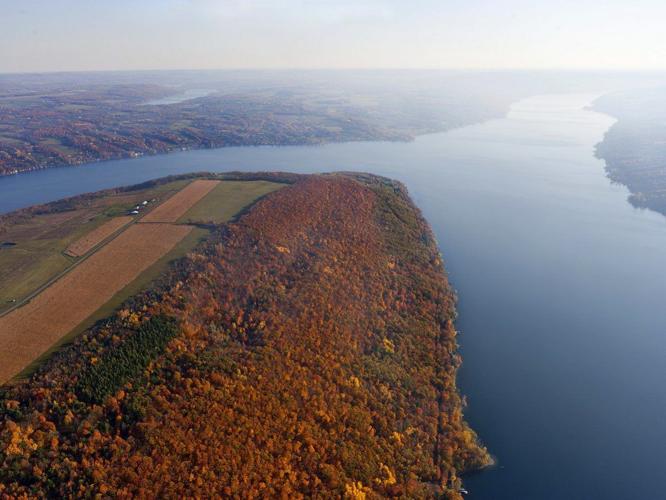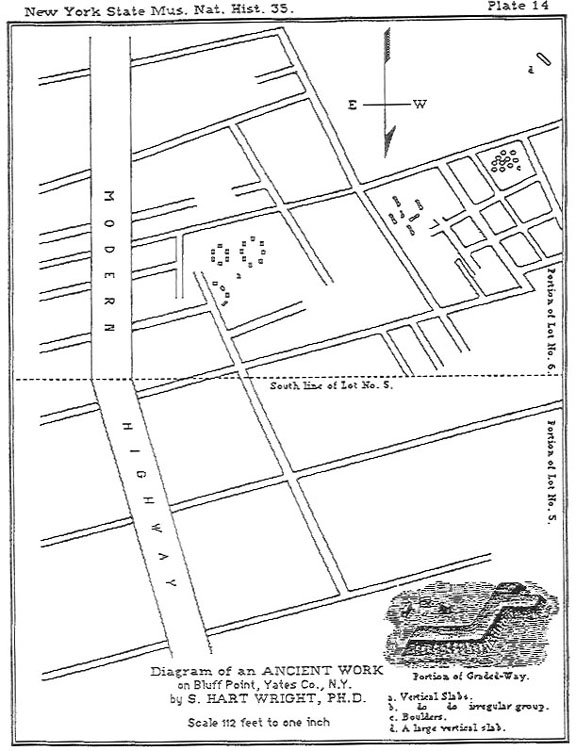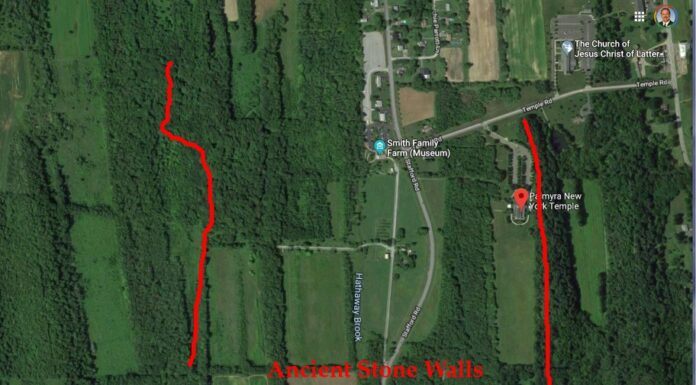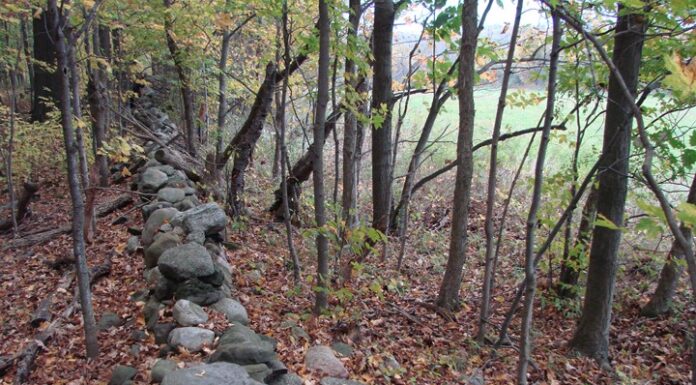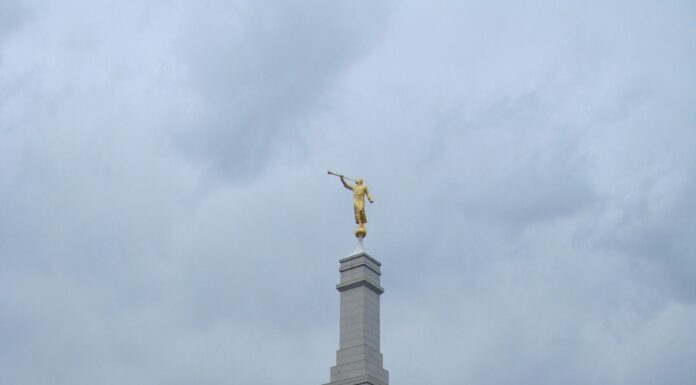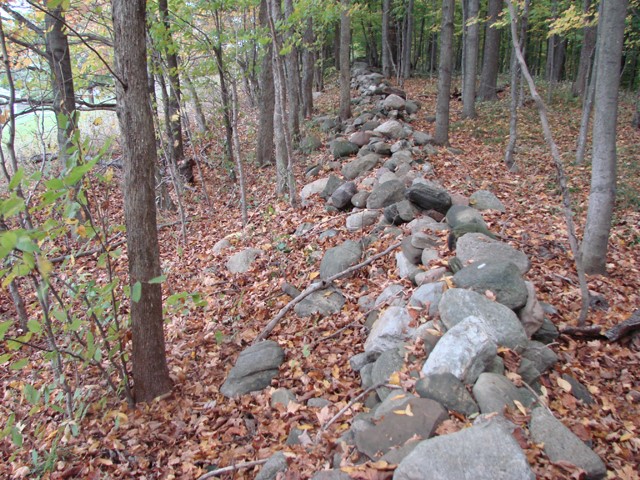
Bluff Point Ruins/Jerusalem New York
“Of all the Native American sites found in Yates county the “Bluff Point Ruins” are the most mysterious. Two surveyors Berlin H. Wright and Samuel H. Wright, a father and son, discovered this site. Both men accomplished many remarkable things during their lives. Their reputations as highly educated, thoughtful men gives credence to their account of the strange arrangements of stones found on the top of the hill high above the shores of Keuka Lake. Samuel H. Wright wrote an extensive account of the plants and animals found in this area in William Stork’s book A Student’s Handbook of Yates County. Berlin wrote a very accurate description of the geology of the county in the same book.” Bluff Point Ruins
The Bluff Point ruins are only 30 miles south of Hill Cumorah near a small city named Jerusalem, NY. It is also only about 35 miles from Fayette N.Y. where the Prophet Joseph Smith and Oliver Cowdery finished translating the plates. 
A good friend of the Heartland and myself, David Read sent me the article below titled, “Mysterious Ruin at Bluff Point” which I have enjoyed very much. It continued my research in the New York area. Anything near Hill Cumorah and Palmyra is a lot of fun to investigate. Did you know the first Natural Gas and Oli was found in New York just 100 miles south of Cumorah near Cuba, NY and 130 miles southwest of Cumorah near Fredonia, NY. See Map above for locations.
 Be sure and read David’s book, it validates Book of Mormon and Nephite DNA in my opinion.
Be sure and read David’s book, it validates Book of Mormon and Nephite DNA in my opinion.
Important DNA evidence has been in front of scientists and researchers for years but only now is being examined and interpreted seriously now. For Latter-day Saints who have grown concerned about apparent anachronisms presented by DNA science the Book of Mormon, this treatise “Face of a Nephite” by Judge David Read, a former patent attorney trained in a wide array of scientific fields, gives readers a close-up and clear re-examination of the evidence and sets the record straight.
Face of a Nephite by David Read, JD Patent Attorney New DNA Studies and the Book of Mormon 110 Pages; Full Color interior
Hopewell/Nephite Battles and the Importance of NY Archaeology
“The battles are described as often having culminated in the destruction of previous, superior Native cultures which had taken final refuge in forts at the tops of hills, including the general region of the hill known to Mormons as Cumorah. In the town of Camillus, in the same county of Onondaga . . . there are two ancient forts . . . One is on a very high hill, and its area covers about three acres. . . . The ditch was deep and the eastern wall ten feet high. In the centre was a large lime stone of an irregular shape.” A Memoir on the Antiquities of the Western Parts of the State of New-York, Addressed to the Honourable Samuel L. Mitchill, a Vice-President of the Literary and Philosophical Society of New York . . . by Dewitt Clinton . . . Read Before the Society November 13th, 1817 De Witt Clinton (1769-1828)
“How America Was Discovered is a story told by Handsome Lake (Seneca Prophet), and documented by Arthur C. Parker, about a young minister who meets the one he perceives to be the Lord, who then asks him to go to a new land and bring with him cards, money, a fiddle, whiskey, and blood corruption. In return the young minister will become rich. The young minister sought out Christopher Columbus, and with the help of his crew, traveled to the Americas. They turned back to report what they had seen, which caused an immigration of people from Europe to the Americas. Along with the people came the five things that aided in destroying the natives. The end reveals that the “Lord” in the gold castle was actually the devil, and that even he knew what he had caused was wrong.” Rudes, B. Tuscarora English Dictionary Toronto
Pompey in Onondaga County, NY
“Pompey in Onondaga County, a town covering upwards of five hundred acres must have contained a population greatly transcending all our ideas of credibility . . . This town was on elevated ground, . . . and was well calculated for defense. . . . There are three old forts distant about eight miles from each other, and forming a triangle which encloses the town; . . . and they were, in all probability, erected to cover the town and to protect the inhabitants from the attacks of an enemy. . . . On the line of the north side, the town was probably stormed. There are graves on each side close to the precipice; sometimes five or six persons were thrown promiscuously into the same grave. If the invaders had been repulsed, the inhabitants would have interred the killed in the usual places; but from the circumstance of there being graves near the ravine and in the village, I am induced to believe that the town was taken. (noting ‘gun barrels, axes, hoes and swords . . . all over these grounds’) The traditions of the Indians agree in some measure with the French relations. They represent that their forefathers had several bloody battles with the French . . . There is a hill in Pompey, which the Indians will not visit, and which they call Bloody Hill. . . . The old fortifications were erected previous to European intercourse. The Indians are ignorant by whom they were made; and in the wars which took place in this country, it is probable that they were occupied as strong holds by the belligerents; and it is likely that the ruins of European works of a different construction may be found… it is remarkable that our ancient forts resemble the old British and Danish. The Bloody Hill site dated by modern archaeology to ca. 1420 A.D. has been excavated carefully in modern times, yielding comparatively superior ceramic artifacts. Significantly more Native sites are now recognized in Pompey, beyond the few which [DeWitt] Clinton knew or was able to visit.” (James A. Tuck, 104-119) Mormon Parallels: A Bibliographic Source 2014 Rick Grunder page 403. Map from “Onondaga Iroquois Pre History A Study in Settlement Archaeology” James A. Tuck 1971 page 20
Joseph Smith in Onondaga County NY
“Onondaga was a name that Joseph would have heard frequently in the Indian lore which B. H. Roberts felt must have influenced Joseph during his early days in Palmyra… Indeed, in order to reach Palmyra in company with Lucy Mack Smith and his siblings when they emigrated from Vermont, Joseph had to traverse the important township of Onondaga, through which the original Genesee and Seneca Turnpikes still run today…” Mormon Parallels: A Bibliographic Source 2014 Rick Grunder pg. 1125
“Contrary, then, to widespread assumptions during Joseph Smith’s lifetime that the Onondaga migrated to the New York region, it becomes clear that they originated here as a small, narrowly localized amalgamation of a few villages near Onondaga Lake, during the century before Columbus’ discovery of America” Beauchamp’s Aboriginal Place Names of New York;
Iroquois Nation Principle Tribes: Onondaga, Mohawk, Oneida, Seneca, Cayuga, Tuscarora
“The Onondaga at the great white pine tree in Syracuse NY on the shores of Onondaga Lake is where the message of peace was planted and the hatchets were buried. Similarly, the Lamanites , “…buried the weapons of war, for peace.” Alma 24:19
Ganargua Creek (Mud Creek) was a primary stopover point for the Iroquois on their trade routes. Joseph Smith also had an interest in the creek after hearing a speech from Seneca Indian Chief Red Jacket at Palmyra in 1822.
Many historians believe that Iroquoian ideas of federalism, and balance of power directly influenced the US system of government. Benjamin Franklin admired native American government structures. In 1744, Canassatego advocated in Washington the federal union of the American colonies.
The Onondagas: These have special interest… this warrior, Zelph, was an Onondaga, as well as a “white” Lamanite, and that the Onondagas (of New York), consequently must be of Lamanite lineage.” J.M. Sjodahl, An Introduction to the Study of the Book of Mormon
Mormon Buried? Mouth of the Oswego River
Chief of Seminole Tribe: “We had a war long ago with a light skinned people around the Great Lakes. We conquered them but we had so much respect for their warrior chief that we buried him at the mouth of the Oswego River that is in New York State. We don’t discuss this very much because it is an embarrassment to us. President Rawson then asked why this is an embarrassment, and the Chief replied, “ Our history is written on metal plates and buried in a hill in New York, but we don’t know which hill!” (Talk given to missionaries in training at the MTC, Provo, Utah 1979, by President Murray J. Rawson).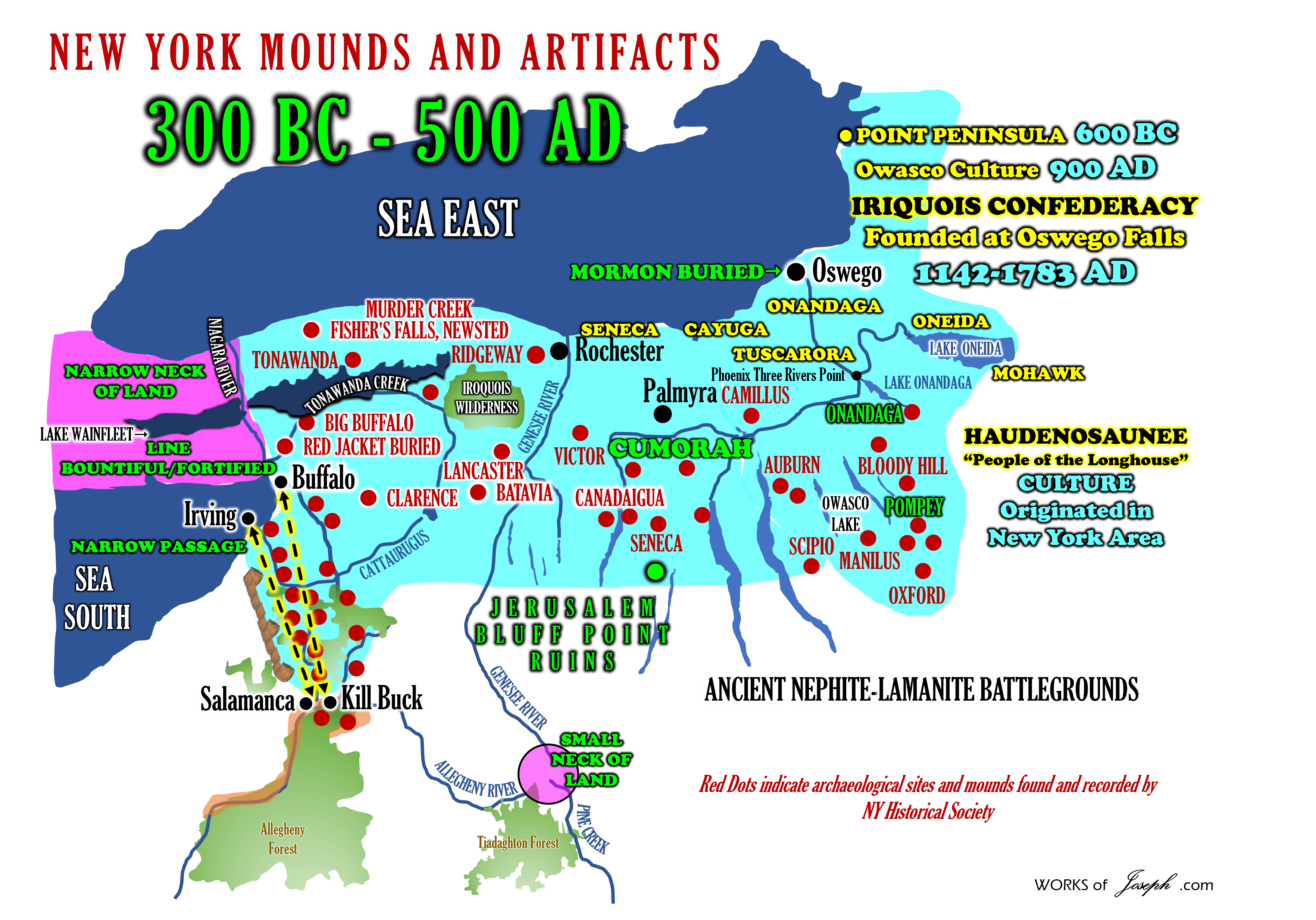
LOOKING BACK: The mysterious Bluff Point ruins of Jerusalem
Mysterious Ruin at Bluff Pointby David D. RobinsonThere is no trace above ground today of the elaborate, extensive, grid-patterned ruin of the Celtic-like “village” that was once situated on Bluff Point above Keuka Lake. The ruin is on Skyline Drive, about four miles south of Keuka Park, New York, which is just off Route 54-A. On the Yates County highway map, Keuka Park is marked “Site of Primitive Mound Indians.” There are two mounds on Skyline Drive, one quite close to the ruin site and directly north of it. Detailed reports of the ruin come principally from only three sources that I can find: The geological survey was made by Dr. Samuel Hart Wright, MD, who also held an MA degree from Williams College, was a land surveyor, and an internationally recognized biologist. He was assisted by his son, Berlin Hart Wright, MD. One of the first owners of the land, Howland Hemphill, who lived on the site for 50 years, is mentioned by Berlin Hart Wright: “Mr. Hemphill was an aged man at the time of our survey. He said he came to the farm as a young man when the Indians were all about. In answer to a question…he was informed that. ..(the ruin)… was there when the earliest tribesman came to the region.” The 1938-1939 excavation by many persons was carried out under the direction of a newspaper reporter from Canandaigua, New York, Mr. Gilbert T. Brewer. The general appearance of the site did not seem to have changed much from 1880 until as recently as 1954 when the author A. Glenn Rogers visited there and wrote a brief account of it. I am sorry to report that by 1985, and probably a decade or two earlier, the above ground remnants of the site had been almost completely obliterated by vineyards, drainage ditches, hay fields, farm work roads and a pine plantation. Inside the pine plantation are two or three shallow depressions with several mounds of earth next to them, probably all the remains of the 1938-1939 excavation. The schematic ground plan of the site made from the 1880 land survey covers 13 acres of the ruin. The ruin was usually described as being between 14 and 20 acres in extent. The plan shows seven principal walls running roughly NW – SE, one short wall running N – S, and 12 principal walls running roughly NE – SW. At the time the survey was made, Dr. Wright reports that the land in Lot 5 (the northern five acres) shown on the plan had been plowed, and some detail there was surmised by the Wrights from surface rocks. The southern eight acres (in Lot 6) had never been plowed, was unforested, and much detail was visible, as is obvious from the plan and from written reports. Among other things, the 1880s plan shows ten “rooms” that, had they been roofed over, might have been dwellings or storage rooms, generally about 30 x 40 feet or slightly larger. There are also four still larger “rooms” that might have been enclosures, for what, is unknown, and two enclosed areas that might have been for ceremonial purposes. One of the latter might have been a large antechamber. The other seems to have enclosed two stone circles each with a diameter of about 30 feet, and a segment of a third circle of similar size. Most of the rest of the ruin seems to have consisted of walls which might have enclosed fields. Except for their size and regularity, the “fields” are not unlike prehistoric and medieval farming fields, consisting of long, relatively narrow strips separated by stone walls. English archeologists call such fields “Celtic Fields.” No one had reported burials in connection with the site. An account written by Berlin Hart Wright in 1880, or shortly thereafter, states in part, “The remains of the ancient structure consisted of the foundations of the walls, in the form of graded ways three to eight feet wide and one to two feet high, bordered with a vast number of large, flat stones set in the ground edgeways, these stones leaning inward toward the center of the ways. At points of intersection of some of the walls, depressions indicated posts had been standing there at one time, evidently supporting a roof.” ( See Blog here called Earth & Wood Buildings/Hidden Cities/Great Hopewell Road/Graded Ways by Rian Nelson Dr. Wright’s account published in the 1884 Thirty Fifth Annual Report of the New York State Museum of Natural History, by the Regents of the University, pages 193 and 194 states: “All the areas between these ways are depressions, in which water remains until evaporated, the nearness of the rock below, often being only twelve or fourteen inches, prevented its absorption. These areas, or many of them, contain bogs of carex, and some grass, but in the summer are dry and afford a fair pasturage. The dirt used to make the ways was taken from these areas causing the depressions, and the rock beneath was no doubt at that time completely laid bare and furnished the flat stones that are set in on each side of the graded ways.. .No trees are in the structure except a few young ones.” |

